Beneath the Surface: Are the Cu Chi Tunnels Worth Visiting?

Are the Cu Chi Tunnels worth visiting? With a powerful glimpse into Vietnam’s wartime history and the resilience of its people, the Cu Chi Tunnels leave a lasting impression on every visitor. Read on to uncover what makes this experience truly unforgettable.
Contents
Cu Chi Tunnels – An overview

Cu Chi Tunnels, ‘the city in the ground,’ are a true wonder of Vietnam’s unique military art and one of the symbols of revolutionary heroism.
Cu Chi Tunnels – The underground network of resilience
Cu Chi Tunnels were initially built during the First Indochina War (the Anti-French Resistance War in Vietnam), roughly in 1948. The very first parts of the tunnels took shape in Tan Phu Trung and Phuoc Vinh An Wards of Cu Chi District, and the name Cu Chi Tunnels also started since then. In its early days, Cu Chi Tunnels were just simple interconnected passageways built underground to store confidential documents and shelter Vietnamese resistance fighters.
During the Vietnam War (the Anti-American Resistance War in Vietnam), Cu Chi Tunnels were expanded and developed into a complex underground network, playing a crucial role in Vietnam’s guerrilla warfare. Until January 1967, Cu Chi’s locals and fighters, with their simple tools and bare hands, successfully constructed an intricate underground network with a total length of over 250 km and three layers with the deepest 10 metres from the surface. Cu Chi Tunnels turned into a hidden village, where life persisted despite heavy bombings on the ground. The tunnels served as meeting rooms, hospitals, and social areas where people lived in extreme conditions. As the tunnels were usually wet and suffocating, every movement required strength and patience. In the rainy season, things got worse when the tunnels were infested with ants, snakes, scorpions, spiders, and rodents.
Cu Chi Tunnels map

The tunnel system spans three levels, with a central ‘backbone’ from which countless long and short branches extend and interconnect – some even reaching all the way to the Saigon River. The first level, located 3 metres underground, was designed to withstand bullets and the weight of tanks and armoured vehicles. The second level, situated 5 to 8 metres below ground, provided protection from minor bomb blasts, while the third level, buried 8 to 12 metres deep, was built to withstand even the most powerful explosives.
Along the length of the tunnels, strategic choke points were built to block enemy advances and prevent the spread of toxic chemicals. Some sections were so narrow that only individuals with small builds could squeeze through. Some entrances were cleverly disguised as firing positions, blending seamlessly into the surroundings to avoid detection. Surrounding the tunnel entrances were numerous deadly traps – spike pits, nail holes, and mines – collectively known as ‘death zones.’ These included large anti-tank mines and cluster bomb launchers, all designed to deter and disable approaching enemy forces.
» See more on Cu Chi Tunnels Experience: Recall Vietnam’s Underground War
Cu Chi Tunnels interesting fact
The construction of the Cu Chi Tunnels is a remarkable feat in itself. Many visitors come to the Cu Chi Tunnels to discover real wartime stories and fascinating facts that highlight their historical significance.
1. Secret entrances and traps
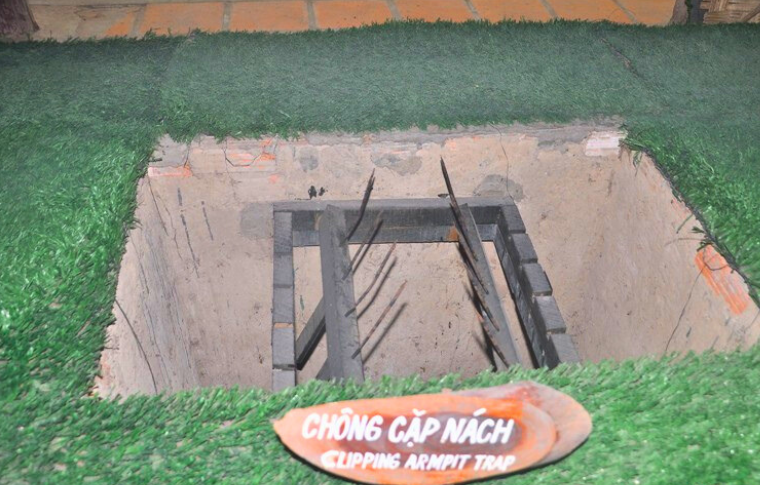
An essential part of every visit to the Cu Chi Tunnels is viewing deadly traps up close. The Viet Cong fighters were not equipped with advanced weapons, but their creativity turned basic materials into effective traps that outwitted and wounded even the most well-equipped enemies. Most traps, though simple, proved to be incredibly dangerous and effective and inflicted substantial losses on American forces. Here are some examples:
• Hầm chông bẫy cọp (trou-de-loup): A deep pit filled with razor-sharp bamboo or iron spikes that caused serious injuries to those who fell in. Hidden snipers positioned nearby were ready to strike the moment they heard a victim’s scream.
• Chông cần cối (seesaw trap): Operating on a lever mechanism, this trap included iron spikes mounted on seesaw-like boards. When a person stepped on one end, the opposite end would snap upward, driving the spikes into the chest or head with deadly force.
• Chông trục quay (rotating trap): This rotating trap was lined with iron nails. When triggered, the trap would spin rapidly, inflicting multiple deep puncture wounds in a matter of seconds.
• Chông hòm (box trap): Designed like a square basket with spikes at the bottom, the trap was often placed in rice paddies or muddy riverbanks. Once stepped on, the spikes immobilised the victim.
• Chông thò (pop-up spike trap): Ironically dubbed “Vietnamese souvenirs,” this trap featured sharp nails embedded in a circular board. When triggered, the nails would pierce the victim’s thigh and ankle. The injured American soldier was typically evacuated to a military hospital, often with the embedded nails sent along as grim mementoes of the encounter.
2. Hoang Cam stove
The smokeless Hoang Cam stove was a small yet important initiative of a soldier chef of the same name in the war against French colonialists in the mid-1950s. After several design attempts, Hoang Cam made a stove as he wished – a wood-burning stove with the special smoke channels covered with tree branches and damp dirt on top. Smoke from the furnace spread out into the channels, filtered and concealed by the earth. As it rose, it resembled morning mist and quickly vanished, preventing itself from being detected by the military plane. Hoang Cam stove was used in the Cu Chi Tunnels during the Vietnam War to cook meals for the Viet Cong soldiers, contributing to the secrecy and sustainability of their underground resistance.
3. Tunnel rats
To combat the underground forces, the US military needed a new approach – tunnel rats. They were small-built soldiers who crawled headfirst into dark, claustrophobic tunnels to detect traps and gather vital intelligence. They had no fancy equipment; at most, they were equipped with a 4.5 pistol, a knife, and a flashlight. Some men carried out dozens of underground incursions, gradually accustomed to the confined spaces while others discovered they had major phobias and could not continue their missions. The snug, dark tunnels turned into a real nightmare for the Americans. Tunnel rat infiltration succeeded up to a certain point, but the local guerrilla units took back Cu Chi when US operations in the area ceased.
4. The ‘barren land’
During the 1969-1972 period, Cu Chi was called the ‘barren land’ because the intense bombing and use of Agent Orange and dioxins by US forces made it uninhabitable for both animals and plants. This is part of the Operation Ranch Hand over rural areas of South Vietnam to deprive the Viet Cong of food and vegetation cover. It is estimated that the chemicals caused around 400,000 deaths due to a range of cancers and other ailments. According to the Vietnamese government, the US campaign caused three million Vietnamese health problems, with children born with severe birth defects and many areas being defoliated.
5. Ben Duoc Memorial Temple
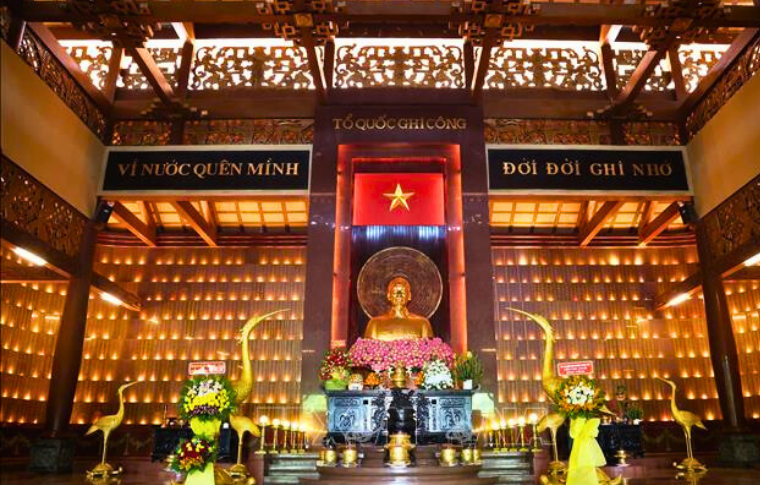
Ben Duoc Memorial Temple was built in memory of the significant contributions of the soldiers and people who were killed in Sai Gon – Gia Dinh during the wars against the French and American armies. Located in Ben Duoc Hamlet, Phu My Hung Village, part of Cu Chi Tunnels, Ben Duoc Memorial Temple is flanked by a nine-storey tower with a flower garden at the front.
The main temple looks like a sacred, ancient Vietnamese temple arranged in a U-shape. In the centre of the temple sits an altar, and in the middle lies a statue of President Ho Chi Minh. On the left and the right sides are two altars to worship the ancestors, martyrs, and unknown soldiers who have sacrificed for the country.
6. Re-used unexploded American bombs
The construction of Cu Chi Tunnels is just one example of the ingenuity of the Vietnamese in wartime, and there are many more. Harsh conditions in the past had shaped their ability to transform disadvantages into unexpected and effective tactics. Some types of bombs dropped onto the land failed to explode, but the Viet Cong fighters saw those as golden opportunities. They came up with the idea of collecting the unexploded bombs, cutting them open by hand, draining the explosive powder, and then re-using it in their own booby traps. Ironically, bombs dropped by the Americans were made into weapons against the Americans and their allies.
Are the Cu Chi Tunnels worth visiting?
The Cu Chi Tunnels are definitely worth a visit for the wide range of experiences they offer, from crawling through the tunnels to exploring unique lethal weapons. Even when you have mobility issues or simply don’t want to get stains on your clothes, you don’t have to go underground to fully experience the site. Above the ground, war remnants, informative exhibits, and immersive storytelling bring the tunnels’ history to life. The Cu Chi Tunnels trip can be both moving and educational, giving you valuable lessons about the past war and the value of peace.
The tunnels perfectly fit into a day tour in Ho Chi Minh City. You can visit all the landmarks in the city centre before departing for the Cu Chi Tunnels on the outskirts. Alternatively, combine the Cu Chi Tunnels with the War Remnants Museum to experience the Vietnam War through multiple perspectives and narratives. The War Remnants Museum is a must-see spot in Ho Chi Minh City that offers a thought-provoking look into the war and its lasting impact. If you seek a significant landscape change, consider visiting Cu Chi Tunnels and the Mekong Delta – the two places that will make for an immersive experience, allowing you to learn both history lessons on the ground and life stories along the river.
So, if you are totally convinced to visit the Cu Chi Tunnels, one concern left – Are the Cu Chi Tunnels safe? Are you afraid of suffocation, snakes, and tight spaces? Leave your worries aside, the tunnels are safe to visit. Unless you have a specific health condition, feel free to explore the tunnels as much as you can. Though the tunnels are incredibly narrow, the sections that open to the public were enlarged to accommodate most body types. There’s no way you will get stuck. Also, the ventilation and light systems have been well-installed to make visitors feel safe and comfortable. As for insects at Cu Chi Tunnels, the truth is you may get some mosquito bites, but that’s all; there are no venomous snakes or deadly bites. For an extra layer of protection, wear long-sleeved T-shirts and pants, but it’s totally fine if you prefer shorts and sleeveless T-shirts.
Take a look at the following Cu Chi Tunnels photos to gain a better understanding of the site and how visitors enjoyed the experiences there.
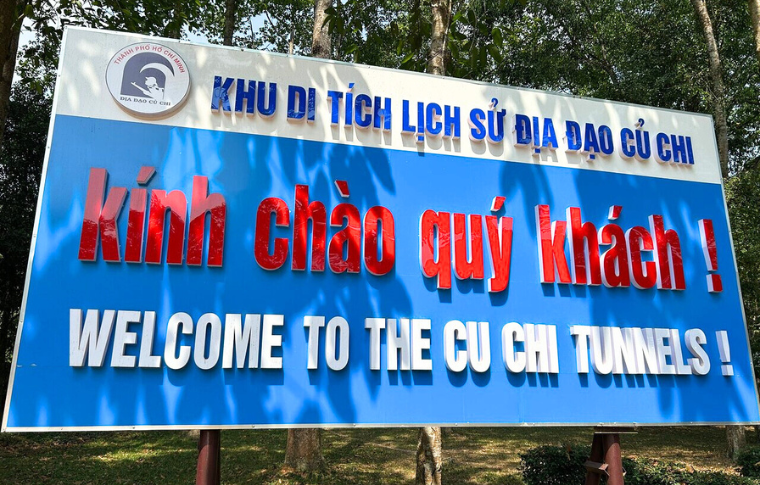
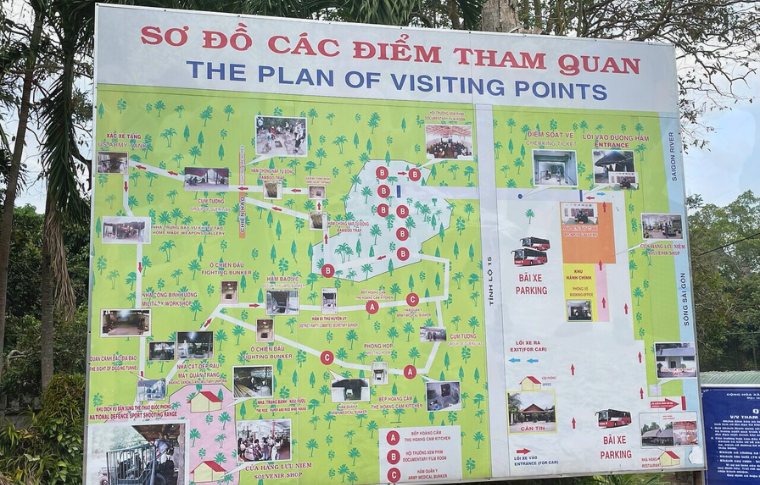

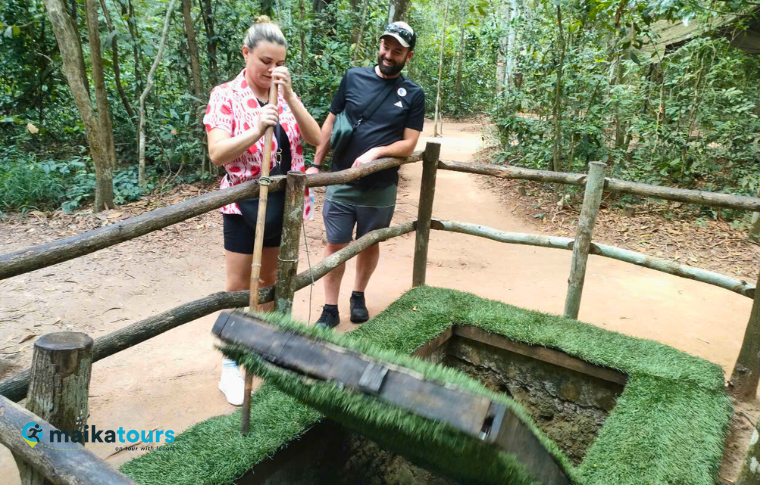
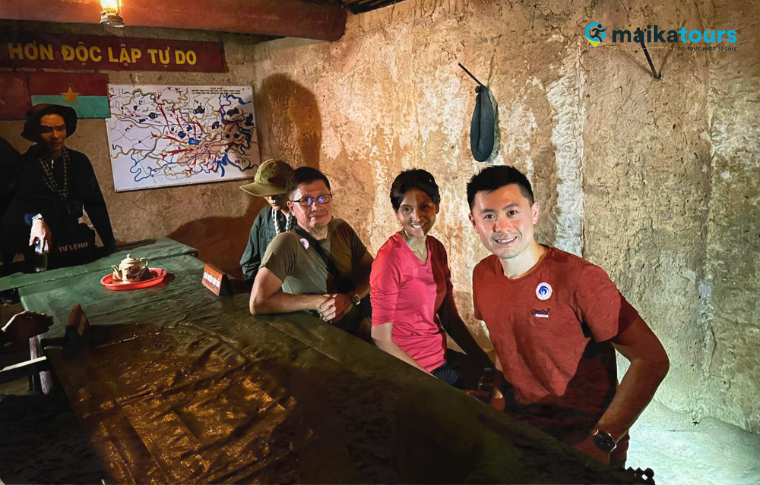
An Essential Guide for Cu Chi Tunnels
Cu Chi Tunnels Experience is one of the most popular day tours from Ho Chi Minh City, and you can make it on either a DIY tour or a guided tour. Read more to find which options suit you best and how to get there.
Cu Chi Tunnels location
Cu Chi Tunnels are located in Phu Hiep Hamlet, Phu My Hung Commune, Cu Chi District, the northwestern part of Ho Chi Minh City. The driving distance between Ho Chi Minh City and Cu Chi Tunnels is approximately 55 km, and you can reach the site directly via either National Route 22 to Provincial Road 15. The journey usually takes about 2.5 – 3 hours, depending on traffic. Cu Chi Tunnels Ben Duoc is farther than Ben Dinh, but it’s less crowded and offers a more authentic experience.
The most common way for independent travellers to get to the Cu Chi Tunnels is by taxi, either a traditional taxi or a ride-hailing app. Travelling by public bus is also possible, but it will take a significant amount of time that should have been spent at the site. Other options include private transfers, guided tours, or express boats.
Cu Chi Tunnels opening hours and entrance fees
Cu Chi Tunnels open every day, from 7 a.m. to 5 p.m. The best time of day to visit the site is early morning (before 9 a.m.) to avoid large groups and extreme heat at noon. As you can combine the Cu Chi Tunnels visit with other attractions in the city centre or even leaving for the Mekong Delta, arrange the time accordingly to make the most of your experience.
The entrance fees at Cu Chi Tunnels are VND 35,000 for Vietnamese citizens and VND 125,000 for foreign visitors. There are no audio guides at Cu Chi Tunnels, so you need to book a guided tour if you wish to learn more about the history onsite.
Cu Chi Tunnels: DIY or Guided Tour?
The Cu Chi Tunnels can be ideally explored on a half-day tour, 3-4 hours, and you can maximise the time for all essential experiences, from the ground to the underground. Enjoy an immersive journey with a thoughtful plan, either the DIY or the guided tour. Here are some pros and cons of the two options to consider:
DIY Tour
• Pros: The DIY Cu Chi Tunnels are ideal when you want to spend more time exploring specific zones, and you don’t mind spending time waiting for transportation. This option is economical and best for solo travellers or groups of adventurous travellers.
• Cons: Without arranged services like transportation, meals, and a local guide, you have to spend extra time covering everything. You might miss out on valuable information about the tunnels’ history, construction, and significance if you don’t have a knowledgeable guide. Moreover, if you travel with kids or people with mobility issues, planning a DIY tour will be a challenge.
Guided Tour
• Pros: For a stress-free experience, go with a guided tour. The biggest advantage of a guided Cu Chi Tunnels tour is a more comprehensive understanding of the site – you know the stories behind the hiding places, hospitals and kitchens during the war. A structured itinerary also ensures you don’t miss any key highlights and essential experiences.
• Cons: Besides the prices, guided tours to Cu Chi Tunnels are often crowded with a relatively big group size, which may impact your general exploration. Since the guide sets the pace for the group, you may not get as much time as you’d like at specific spots. So, if you are willing to pay extra, a customisable guided tour is the best option since it allows you to tailor the experience to your interests and preferences.
Cu Chi Tunnels: Zones to discover

There are key areas to discover in the Cu Chi Tunnels that you need to visit to gain a deep insight into the region’s history. Besides, you can also try your hand at the shooting range for something more fun and relaxing.
1. The underground tunnels
The main part of Cu Chi Tunnels is obviously the underground network that showcases the ingenuity and resilience of the Vietnamese. Cu Chi Tunnels can be visited at Cu Chi Tunnels Ben Duoc or Ben Dinh. Ben Duoc is farther than Ben Dinh, but it is less crowded, with fewer foreign visitors, and offers a more authentic experience.
Originally built beneath the jungle, the underground tunnel system connected various hamlets and communes during the Indochina War. The tunnels served as hiding places for Viet Cong soldiers and were later expanded into makeshift hospitals, schools, and command centres, playing a pivotal role in the war effort.
When you crawl inside the tunnels, it’s better to leave your cumbersome backpack behind. You can explore the tunnels by section, and don’t worry as you can try with a short section first to test your level of endurance. The first section of the tunnels stretches 20 metres, with an optional exit at the 10-metre mark. The second section is 70 metres long and also features an optional exit.
The current Cu Chi Tunnels have been enlarged to make the inside more accessible than the actual tunnels in the past. However, be prepared to experience some discomfort as you are easily sandwiched between people, especially during peak seasons.
2. Cu Chi Tunnels shooting range
Shooting is one of the most favoured activities when visiting Cu Chi Tunnels, particularly for foreign visitors. The shooting range features a variety of firearms, including AK-47, M-16, Type 63 rifles, M30, M60, and PKM. You can try shooting off a few rounds before stopping at the adjacent souvenir and snack stalls for a short break. The cost is calculated per bullet – for example: VND 20,000 per bullet for a K54, VND 23,000 – 25,000 for a Colt 45, K59, Rulo, VND 30,000 – 35,000 for AK(1), Carbin, AK and M16(1). The types used in the military cost more, up to VND 40,000. Supervisors are on hand to load the guns for you, and be sure to wear protective headgear, as the noise can be extremely loud.
There’s also a paintball shooting area, which offers cheaper prices and fun group experiences. You can team up with friends or join other groups to take part in an exciting paintball combat game. You will be provided with masks, uniforms, and body armour to ensure a safe and enjoyable experience.
3. Simulation Liberated Area
The Simulation Liberated Area at the Cu Chi Tunnels Ben Duoc offers a unique opportunity to gain insight into the daily lives of the fighters who once lived there over the period 1961-1972. To visit the simulation zone, you will have to pay an extra fee of VND 85,000. The ideal time to spend at this area is approximately 30-45 minutes, enough to discover the three zones and take in the detailed historical reconstructions.
You will see wax figures in traditional Southern Vietnamese áo bà ba engaging in agricultural activities or recreating scenes of locals and guerrilla fighters carrying goods and produce in their everyday lives. Take the opportunity to travel back in time and experience the atmosphere of wartime Cu Chi.
The Cu Chi Tunnels are more than just a tourist site – they’re a testament to resilience, ingenuity, and history. Contact us for a personalised, in-depth tour that brings the heart and soul of the Cu Chi Tunnels to life.